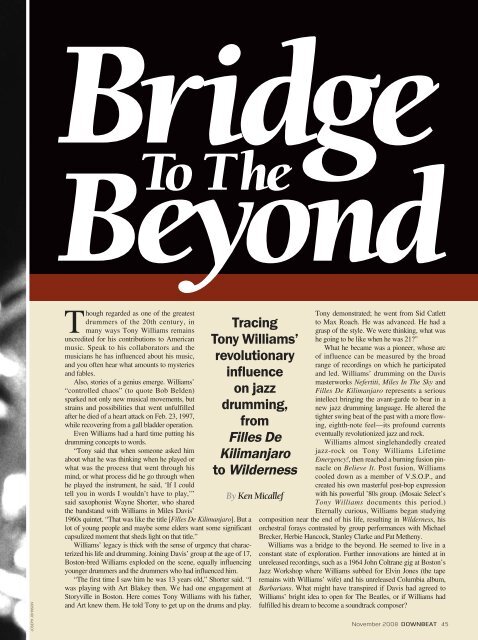Download - Downbeat
Download - Downbeat
Download - Downbeat
- No tags were found...
Create successful ePaper yourself
Turn your PDF publications into a flip-book with our unique Google optimized e-Paper software.
BridgeTo TheBeyondJOSEPH JOHNSONThough regarded as one of the greatestdrummers of the 20th century, inmany ways Tony Williams remainsuncredited for his contributions to Americanmusic. Speak to his collaborators and themusicians he has influenced about his music,and you often hear what amounts to mysteriesand fables.Also, stories of a genius emerge. Williams’“controlled chaos” (to quote Bob Belden)sparked not only new musical movements, butstrains and possibilities that went unfulfilledafter he died of a heart attack on Feb. 23, 1997,while recovering from a gall bladder operation.Even Williams had a hard time putting hisdrumming concepts to words.“Tony said that when someone asked himabout what he was thinking when he played orwhat was the process that went through hismind, or what process did he go through whenhe played the instrument, he said, ‘If I couldtell you in words I wouldn’t have to play,’”said saxophonist Wayne Shorter, who sharedthe bandstand with Williams in Miles Davis’1960s quintet. “That was like the title [Filles De Kilimanjaro]. But alot of young people and maybe some elders want some significantcapsulized moment that sheds light on that title.”Williams’ legacy is thick with the sense of urgency that characterizedhis life and drumming. Joining Davis’ group at the age of 17,Boston-bred Williams exploded on the scene, equally influencingyounger drummers and the drummers who had influenced him.“The first time I saw him he was 13 years old,” Shorter said. “Iwas playing with Art Blakey then. We had one engagement atStoryville in Boston. Here comes Tony Williams with his father,and Art knew them. He told Tony to get up on the drums and play.TracingTony Williams’revolutionaryinfluenceon jazzdrumming,fromFilles DeKilimanjaroto WildernessBy Ken MicallefTony demonstrated; he went from Sid Catlettto Max Roach. He was advanced. He had agrasp of the style. We were thinking, what washe going to be like when he was 21?”What he became was a pioneer, whose arcof influence can be measured by the broadrange of recordings on which he participatedand led. Williams’ drumming on the Davismasterworks Nefertiti, Miles In The Sky andFilles De Kilimanjaro represents a seriousintellect bringing the avant-garde to bear in anew jazz drumming language. He altered thetighter swing beat of the past with a more flowing,eighth-note feel—its profound currentseventually revolutionized jazz and rock.Williams almost singlehandedly createdjazz-rock on Tony Williams LifetimeEmergency!, then reached a burning fusion pinnacleon Believe It. Post fusion, Williamscooled down as a member of V.S.O.P., andcreated his own masterful post-bop expressionwith his powerful ’80s group. (Mosaic Select’sTony Williams documents this period.)Eternally curious, Williams began studyingcomposition near the end of his life, resulting in Wilderness, hisorchestral forays contrasted by group performances with MichaelBrecker, Herbie Hancock, Stanley Clarke and Pat Metheny.Williams was a bridge to the beyond. He seemed to live in aconstant state of exploration. Further innovations are hinted at inunreleased recordings, such as a 1964 John Coltrane gig at Boston’sJazz Workshop where Williams subbed for Elvin Jones (the taperemains with Williams’ wife) and his unreleased Columbia album,Barbarians. What might have transpired if Davis had agreed toWilliams’ bright idea to open for The Beatles, or if Williams hadfulfilled his dream to become a soundtrack composer?November 2008 DOWNBEAT 45
















